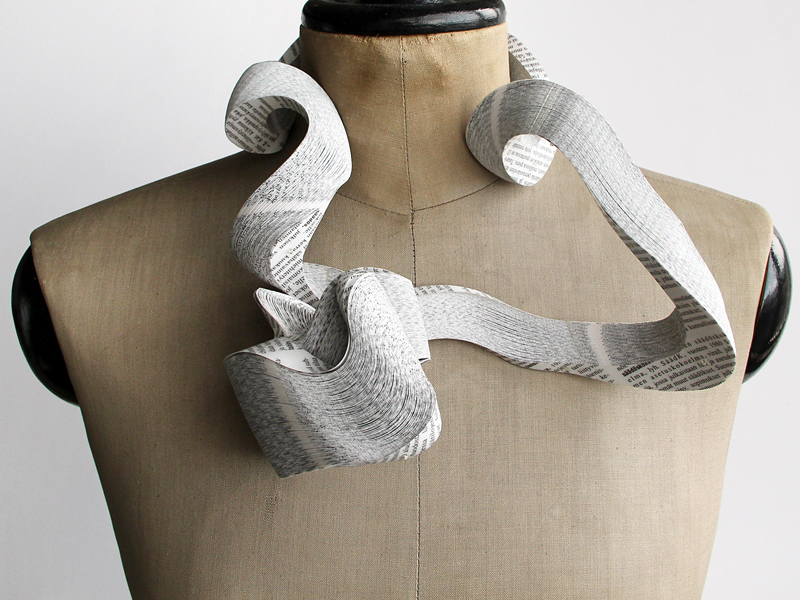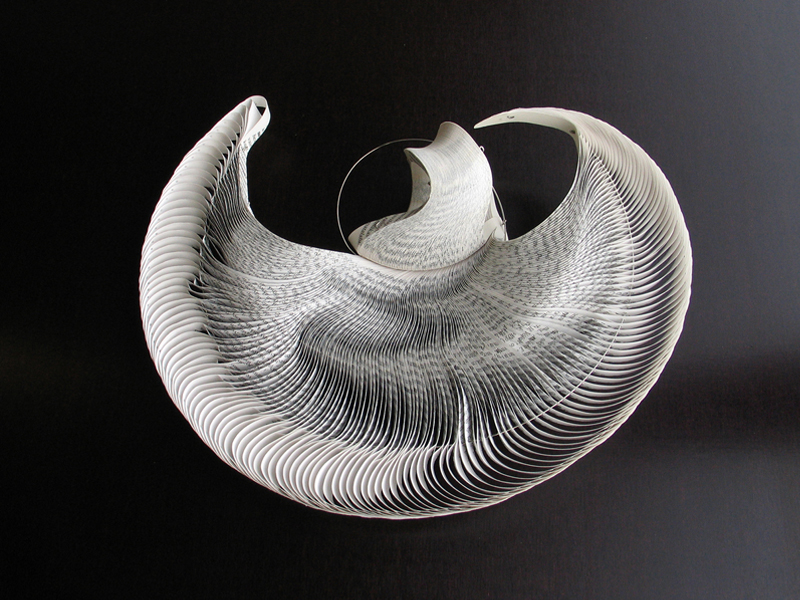
Janna Syvänoja is a Finnish artist who, by a slow and meditative process, creates art jewelry from recycled paper. Using such fragile material, she is able to create depth in form, each slice meticulously layered by hand. Often the original purpose of the material can be read on the surface. Old maps induce a topographical feel, while lines of text evoke soft patterns. Janna’s work is represented by Alternatives gallery, in Rome.
Jessica Hughes: Can you tell us about your background? How did you make the jump from interior architecture and furniture design to art jewelry?
Janna Syvänoja: During my studies I had the chance to train in fine arts: sculpture, drawing, painting, etc. During the late 80s, there was a growing awareness of environmental issues. At university, I took part in workshops dealing with recycled materials and paper. I also got interested in environmental art, and my final project engaged with that field. I never studied art jewelry or design. As a summer job, I started making paper jewelry, and I sold the pieces in the marketplace in Helsinki. That experiment helped me find my way from designer to artist. To work with my hands, and to make my own pieces from start to end, was what I loved to do. But I think that my background as a furniture designer is still present in the way I build my pieces. I always try to use materials in a structural way toward shaping my pieces. My paper jewelry grows into shapes sheet by sheet, without glue, with the help of steel wire and elastic.
Can you tell us a little bit about your process? What is a typical day in your studio like?
Janna Syvänoja: There is no typical day. I work on many projects at the same time, with many materials and different scales, for many exhibitions. What is typical is that I never work on just one piece from start to end, but work on many pieces that are “in progress” simultaneously. The process of making my pieces is usually very time-consuming and involves several phases. Sometimes the work is exciting and surprising, sometimes it is meditative and enjoyable, and sometimes it is just irritating and difficult. It is better for me not to know how much time I actually spend on each piece. My typical day starts late and ends late.

You produce extremely elegant, seductive, and skillful work, and it is hard to imagine what a “failed” Syvänoja piece would look like. Do you ever miss your target?
Janna Syvänoja: I never make any sketches, so my target is quite floating … I enjoy the process—finding some new angle for a common material, learning how to touch it. Sometimes the material and I don’t get on very well. To avoid the feeling that the piece is failed, I let it stay unfinished. I don’t throw it away, but I keep it waiting for a better day. I think that a piece is ready when it doesn’t need me anymore. And when I don’t need it.
Often work that revolves around the idea of recycling or upcycling tries to transform the material beyond recognition, but in your work the original intention is still very apparent. Do you find that is an important aspect of your work? What is the significance of keeping the material’s identity recognizable?
Janna Syvänoja: For me the surface of cut paper pile shows many faces. It reminds me of the whole organic world, like stone, bone, snow, clay, wood, fur, and feather. At the same time, it looks like what it is—paper. Its swerving lines are charming for me. It is like leaving the door a bit open, to give the keys to look deeper, to see. You just have to change the angle: You can find value and beauty in surprising things.

The paper you choose to work with is from telephone books, newspapers, and old maps, items that quickly go out of date. Is this transience what makes them precious in your eyes? There is much speculation that printed books and magazines are part of a dying media. Would you consider expanding your repertoire to include other printed items?
Janna Syvänoja: I use many kinds of papers, depending on the work—thin and thick, printed, colored, transparent—and get accidental gifts. The layout of the books produces lines and patterns on the edge of the cut paper pile. In some areas, one can see letters and words, which give the piece additional meanings. I never color the paper, so the color comes from the previous use of the material. I would say that the printed material is more “rich.” At a certain level it carries along its previous use; its history is still present.
When I started to make jewelry out of paper material (about 25 years ago!), it was an opportune moment, because of the surge of interest in recycling and “green” values. And now the time has come that printed material has become a dying media. What a material paper is! Always of current interest.
Your choice of material suggests an ambivalent relationship to information: You preserve it, but deface it at the same time, making it unusable as information. Can you tell us about this aspect of your work?
Janna Syvänoja: We give out information about ourselves in many ways. Jewelry has a long history as a media of wordless information and communication between people. Sometimes spoken communication between people consists of the wrong words or broken sentences. My paper works, which spell out very little but evoke so much, comment on people’s need for connection and unity.

Would you consider using other recyclable materials like plastic? Or would that be too time-resistant?
Janna Syvänoja: I am not aiming to be time-resistant. By which I mean that I am prepared to work a lot on a piece—although I know that it won’t last forever—if the result is worth it: if I have discovered something through it, and if I can share this experience with other people.
I have used many kinds of materials, and I have been surprised how fragile materials can preserve themselves when they are given a new life under the proper conditions. The choice of material is always an important part of my work—its history is very often the starting point of the story. Plastic would work fine.
You also create sculptures and installations which share a number of the same aspects as your jewelry. How do you approach creating jewelry, as opposed to sculpture and installation?
Janna Syvänoja: I don’t find so much difference on a mental level. The basic ideas behind the work and the approach to the materials are the same. Working in different scales and with many materials provides me with a good variety of experiences.

Your practice straddles several fields—jewelry, installation, sculptural and 2-dimensional work—and presumably several markets. Do they overlap? How do you manage to navigate between one and the other?
Janna Syvänoja: Sometimes I wonder about that myself. I don’t necessarily direct myself to particular market areas. I present my work in exhibitions of various fields. My way of using materials, for example paper, has been considered acceptable in sculpture, jewelry, and textile arts. They seem to overlap across the borders.
Who are you designing jewelry for? Who would you like to wear your work?
Janna Syvänoja: I don’t have a preference. I am happy for anyone to adopt one of my works.

Where do you see your work progressing in the future?
Janna Syvänoja: I am happy enough about what I have achieved so far … but there are still many unwalked paths for me in the fields I work in. I look forward to trying them out.
From where do you get your inspiration? Are you currently reading or seeing anything of interest?
Janna Syvänoja: I go out, to the seaside, to the forest, to the garden, to the city. I stop, look, and touch. That opens my senses, my eyes, my thoughts.
Thank you!
The work in this exhibition ranges from $330 to $3,300.

INDEX IMAGE: Janna Syvänoja, Untitled, 2015, brooch, recycled paper, steel wire, elastic cord, 150 x 100 x 40 mm, photo: Andrea Lombardo




